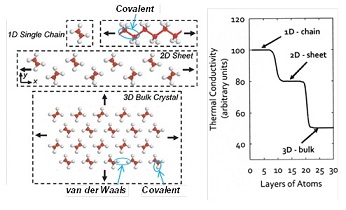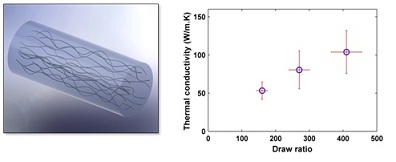Polymers with High Thermal Conductivity
Polymers with high thermal conductivity are of great interest in thermal management systems. Availability of these polymers can expand the plastics industry by partially replacing metals and ceramics in heat transfer devices and systems leading to energy and cost savings. However, bulk polymers usually have low thermal conductivity, ~0.1 - 0.3 Wm-1K-1, due to the presence of defects such as polymer chain ends, entanglement, random orientation, voids and impurities, etc. These defects act as stress concentration points and phonon scattering sites for heat transfer. Typical methods such as introducing a secondary high thermal conductive phase in a polymer matrix enhances thermal conductivity but to just one order of magnitude, due to high thermal resistance between the secondary phase and the polymer matrix. Contrary to conventional wisdom, we show that a single polymer chain can have a very high thermal conductivity when it behaves like a one-dimensional conductor.
Dimensional Crossover of Phonon Transport
Polymers are made up of strong covalent bonds and weak van der Waals forces in intra-chain and inter-chain molecular bonding, respectively. In 1D single chain, the phonon transport is one-dimensional because all of the normal mode wave vectors point in the z direction (i.e. along the chain backbone). Thus, such a single extended polymer chain is likely to have high thermal conductivity by itself due to the orientation and strong covalent bonds. In the 3D bulk crystal structure, where multiple extended chains interact, two phenomena occur; additional modes from the relative vibrations between whole chains and more paths for heat conduction. These modes propagate in the other two dimensions at various angles from the chain backbone and act as an additional phonon-phonon scattering mechanism. These modes have both lower frequencies and group velocities because of the weaker van der Waals stiffness resulting into lower thermal conductivity. In contrary, more paths for heat conduction enhance the thermal conductivity. The interplay between these two effects will determine whether the thermal conductivity will exhibit the increasing or decreasing trend. Using molecular dynamics simulation, we show that the phonon scattering effect of the van der Waals interactions dominates, which gives rise to a 1D-to-3D dimensional crossover in phonon transport from a single chain to a bulk lattice structure1 (Fig. 1). A very high thermal conductivity (> 350 Wm-1K-1), even a divergent one, is possible for a single polyethylene chain2.
Polymer Processing
We fabricated ultra-high molecular weight polyethylene (UHMWPE) nanofibers with thermal conductivity values as high as ~ 104 Wm-1K-1, which is larger than the conductivities of about half of the pure metals3. The high thermal conductivity is attributed to the molecular orientation of polymer chains during ultra-drawing, which improves the fiber quality toward an ideal single-crystal fiber. We utilized a two-stage method; fabricating a fiber at 120 ºC from UHMWPE gel and drawing it at 90 ºC under controlled tension. The x-ray diffraction pattern of the fibers shows the strong single-crystal nature of fabricated polyethylene nanofibers. Thermal conductivity of these fibers are measured by a set-up which utilizes a sensitive bi-material AFM cantilever. This set-up can resolve power measurements as low as 0.1 nW and energy measurements down to 0.15 nJ. Furthermore, we provided a theoretical estimate for the thermal conductivity of a polyethylene bulk single crystal based on molecular dynamic simulations using Green-Kubo approach. Our estimated value of 180 ± 65 Wm-1K-1 indicates that it may be possible to improve the thermal conductivity of polyethylene to a range where it is competitive with aluminum (235 Wm-1K-1). We are now developing an approach for fabrication of polyethylene fibers and films with high thermal conductivity.
References
- Henry, A.; Chen, G.; Plimpton, S. J.; Thompson, A., 1D-to-3D transition of phonon heat conduction in polyethylene using molecular dynamics simulations. Phys. Rev. B 2010, 82 (14), 144308.
- Henry, A.; Chen, G., High Thermal Conductivity of Single Polyethylene Chains Using Molecular Dynamics Simulations. Phys. Rev. Lett. 2008, 101 (23), 235502-235505.
- Shen, S.; Henry, A.; Tong, J.; Zheng, R.; Chen, G., Polyethylene nanofibres with very high thermal conductivities. Nat. Nanotech. 2010, 5 (4), 251-255.

